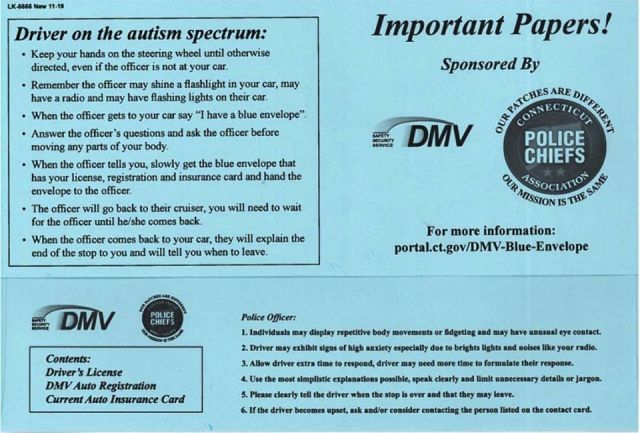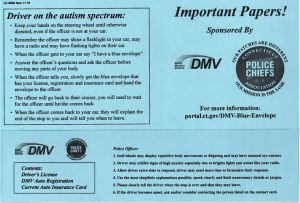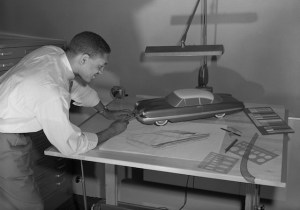Traffic stops are unnerving for most people, but for people with Autism Spectrum Disorder, they can be terrifying.
While every autistic person is different, some can have difficulty communicating and can be upset by bright lights and loud noises, like sirens and radio chatter. They may be confused by a police officer’s questions and give answers viewed as inappropriate, which can lead to tension.
The Blue Envelope Program was developed to reduce stress and avoid miscommunication between autistic drivers and police officers. First introduced in Connecticut in 2020, the program has since been adopted by multiple states, including Maine, Massachusetts, New Jersey, New York, Rhode Island and Vermont.
What Is the Blue Envelope Program?
These are no ordinary envelopes. The Blue Envelope Program makes traffic stops easier for both autistic drivers and police officers.
Drivers use them to store important documents, such as their car registration, insurance card, identification and emergency contact name. The outside of the envelope lists important tips for both the driver and the officer on the best ways to communicate.
When officers see a blue envelope, they know to approach the driver more thoughtfully. Some states also have blue envelope stickers that drivers can put on their vehicle.
Preventing Misunderstanding
Kari Sassu, a psychologist and the codirector of the Center of Excellence on Autism Disorders at Southern Connecticut State University in New Haven, hopes the Blue Envelope Program will help avoid confusion.
“There are too many stories of people being misperceived and taken out of vehicles,” said Sassu, whose son is autistic but does not drive. “People with Autism Spectrum Disorder have atypical communication styles and often make no eye contact. I realize police officers need to make split-second decisions, and when they encounter someone (with autism) on a traffic stop, they might think their answers are snarky. Some individuals are very literal, and their response time is longer, so folks get agitated.”
Practicing Responses
To foster better understanding between police and autistic drivers, the Center of Excellence has hosted training sessions for drivers and police departments, which include practice traffic stops.
Facilitators encourage police to communicate using clear, precise language and deliver a consistent message. For example, “I’m going to reach into the car, get the blue envelope, step away from the car and then come back.”
During the drills with police officers, instructors tell drivers what to expect when they are pulled over and practice appropriate responses. Practice is critical for autistic people, Sassu added.
Autism Speaks, a national advocacy organization for people with autism, also offers resources to promote better interactions between law enforcement and autistic people.
Enough practice and awareness can help make a difference.
“I think it’s positive, it’s a wonderfully intended tool,” Sassu said of the Blue Envelope Program. “But it’s only as good as the ability to use it effectively. This allows us to build a bridge between these two communities.”
If your state and county participates in the Blue Envelope Program, blue envelopes are available at police stations, driving schools, DMV locations, online or through autism advocacy groups. In Rhode Island, you can get one at AAA branches throughout the state.
Have you heard of the Blue Envelope Program? Tell us in the comments.
Featured image: Blue Envelope for autistic drivers. Courtesy of the Connecticut Department of Motor Vehicles.















